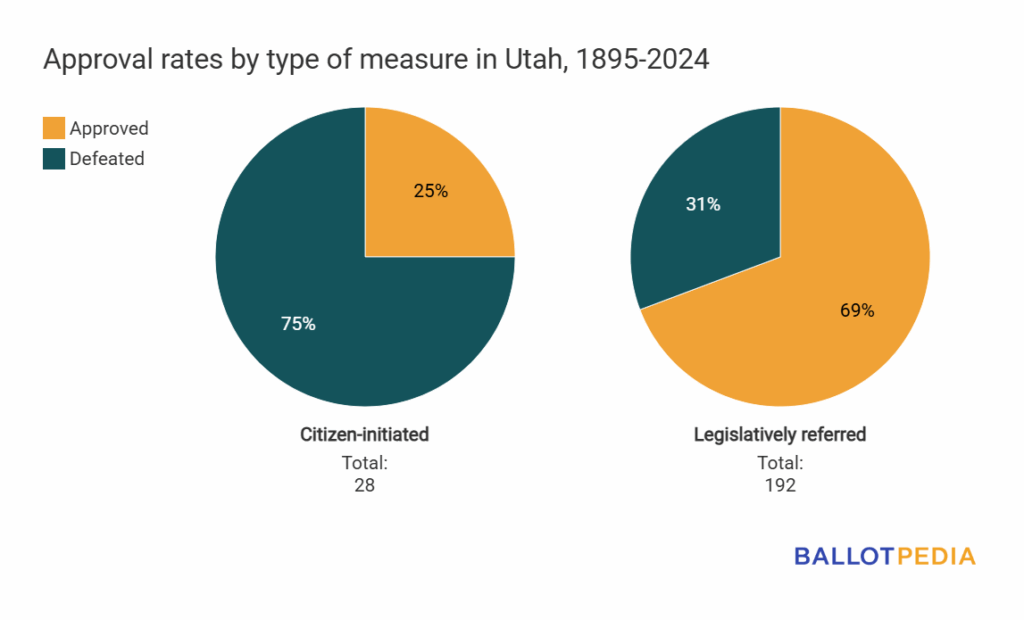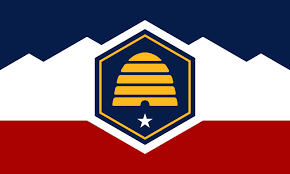Ballotpedia completed an inventory of all Utah ballot measures dating back to 1895, when voters approved the state constitution. Between 1895 and 2024, Utahns voted on 220 ballot measures—140 (63.6%) were approved and 80 (36.4%) were defeated. This count includes the ratification of the state constitution by voters in 1895, two months before the United States Congress granted Utah statehood in Jan. 1896.
In Utah, citizens have the power to initiate state statutes (direct or indirect) and veto referendums. In 1900, 71% of voters approved a constitutional amendment making Utah became the second state in the nation, after South Dakota, to establish an initiative and referendum process. In Utah, the state legislature has the power to refer constitutional amendments, advisory questions, and constitutional convention questions to the ballot. Constitutional amendments require approval from a two-thirds vote of each chamber during one legislative session to be placed on the ballot, and do not require the governor's signature.
The Utah State Legislature referred 192 ballot measures to the state ballot between 1895 and 2024—nearly seven times the number of initiatives (28) placed on the ballot by citizens. Legislatively referred measures were approved 69.3% of the time, as compared to 25.0% for ballot initiatives.
Utah ballot measures have addressed 116 unique topics, with some addressing multiple topics in one measure. The top three topics were property taxes and exemptions, public education funding, and salaries of government officials. Other notable issues included school choice policy, the initiative and referendum process, drinking water systems, and English language policy.
- In 1900, Utah became the second state to approve a constitutional amendment establishing an initiative and referendum process.
- Voters amended the state constitution to prohibit alcohol in 1918, and then repealed prohibition 15 years later in 1933.
- In 1920, voters rejected a constitutional amendment that would have allowed cities to create their own charters and established a process for doing so. Voters decided on the proposal for a second time in 1932, when the constitutional amendment was approved.
- The first veto referendum on the ballot in Utah challenged a law that imposed a special tax and license fee on chain stores, defined as businesses operating 10 or more locations in the state. On November 3, 1942, 69.3% voted to repeal the law.
- In 1970, Utah voters approved Proposition 2, which required proposed constitutional amendments to follow a single-subject rule.
- A constitutional amendment was on the ballot in 1974 that would have created the office of lieutenant governor, abolished the office of secretary of state, and required the governor and lieutenant governor to run together on the same ticket during an election, among other changes. Voters rejected the amendment with only 44.9% voting yes. In 1980, another constitutional amendment was on the ballot, which was nearly identical to the 1974 measure. This time, voters approved the amendment with 56.0% voting yes.
- In 1976, an initiated statute was on the ballot that would have authorized citizens to recall any public officer through a vote during a special election. Voters rejected the initiative by less than a percentage point; 50.2% voted no.
- Voters approved a 1976 initiative, prohibiting the State Board of Health from adding fluoride or other medications to public water supplies without a voter-approved initiative allowing such additions.
- Initiative A was on the 1988 ballot; it would have limited property taxes to 1% of a property's value and required local governments to receive voter approval when increasing taxes or implementing new taxes. The initiative was defeated with 61.3% voting no.
- Two citizen-initiated ballot measures concerning school choice policy have appeared on the Utah ballot. In 1988, voters defeated Initiative C, which would have created an income tax credit program for private and homeschool education expenses. In 2007, voters repealed House Bill 148 by rejecting a veto referendum. The contested legislation would have established an education voucher program in the state.
- In 1994, voters amended the constitution to grant additional rights to crime victims.
- Also in 1994, voters defeated Initiative A, which would have created term limits for congressional, state, and local offices and required runoff elections if no candidate achieved over 50% of the vote in an election.
- Utah voters approved a constitutional amendment in 1998 that required a two-thirds (66.67%) vote to approve ballot initiatives relating to hunting and fishing.
- In 2000, Utah became the eighth state to approve a ballot measure adopting English as its official language.
On average, around 16 measures appeared on the ballot each decade. The average percentage of measures approved was 60.2%. The decade with the most ballot measures was the 1980s, which featured 24 ballot measures. Fifteen measures (62.5%) were approved, and nine (37.5%) were defeated. The decade that had the highest approval rate was the 1940s, which featured 14 measures—12 (85.7%) were approved, and two (14.3%) were defeated. The decade with the lowest approval rate was the 1890s. The decade featured six ballot measures—one (16.7%) was approved and five (83.3%) were defeated.

There are six different types of ballot measures in Utah, and all have appeared on the ballot between 1985 and 2024. Legislatively referred constitutional amendments have appeared on the ballot the most number of times (188). Legislatively referred constitutional amendments also had the highest success rate at the ballot box, with 70% of the 188 measures approved by voters.

The inventory of Utah statewide ballot measures is part of Ballotpedia's Historical Ballot Measure Factbook, which will document nearly 200 years of direct democracy in the United States. This ongoing research effort will provide an unparalleled resource for researchers, reporters, and the voting public on how ballot measures have evolved, the issues they've covered, and the role they have played in our civic life.


